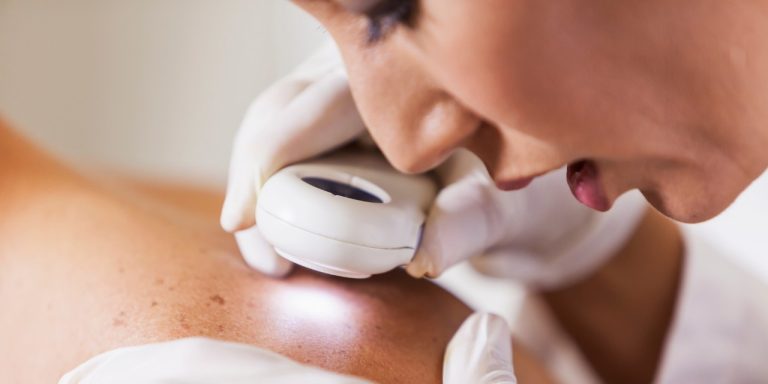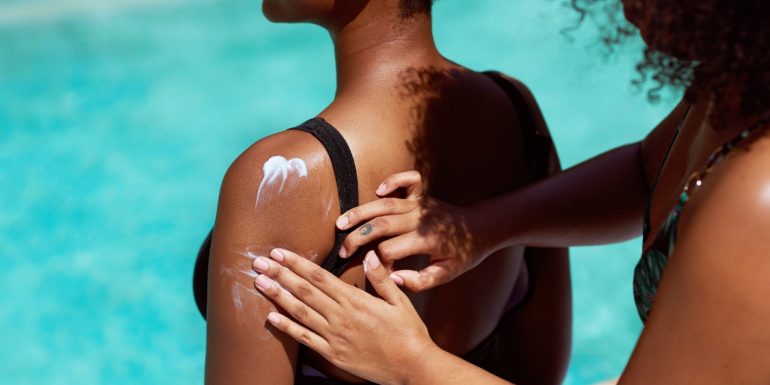
Skin cancer: prevention is the key
Over 3,000 people in Switzerland are diagnosed with malignant melanoma (skin cancer) every year. Most cases are caused by exposure to UV radiation from the sun. To protect your skin, you will need to limit your sunbathing and always use sunscreen.
Prevention can save lives
The sun’s rays have positive effects on people: they encourage metabolic processes, lift your mood, boost vitamin D production and help you relax. If, however, you expose yourself to too much sun, its ultraviolet rays can be damaging in both the short and long term. More and more people today are suffering from skin problems brought on by sunlight. Most skin cancer cases result from too much exposure to the sun. Other risk factors include genetic predisposition, light skin tone and the number of pigmented lesions.
We often underestimate the effect of the sun. We are not sufficiently aware that our skin can also get damaged without our having sunburn, and UV exposure can be high even on cloudy days. Sunscreen with a high UVA and UVB protection factor is just as essential as protection against UV by wearing the right clothing.
When should we have a skin screening?
Although our skin is easily accessible and it is generally easy to recognise suspicious changes, the benefits and risks of skin cancer screening through a full-body examination are still unknown. Using the ABCDE rule (see below), unusual moles can be identified and monitored. Only people with a lot of pigmentation spots or other risk factors are recommended to have regular mole checks by a doctor.
Keep an eye on your moles using the ABCDE rule
The ABCDE rule can help to distinguish a mole from melanoma: if any one of the five points apply in the case of a mole, you should consider seeing a doctor.
A: Asymmetry: a mole that is not round or oval in shape
B: Border: the edges are irregular or blurry
C: Colour: a mole that has different colours (brown, red, white, etc.)
D: Development: a mole that changes size, shape, colour or thickness quickly
E: Elevated: the mole isn’t flat but protrudes above the level of the surrounding skin
Important: the ABCDE rule can provide useful clues, but it’s no substitute for a mole check-up performed by a doctor. Also, benign skin lesions can have one or more of the characteristics shown. Noticing that a mole you have had for a long time has changed – i.e. it has grown in size or changed shape or colour – can be a cause for concern. The same applies if you are experiencing itchiness in this area or the spot is bleeding. If this is the case, you must consult your doctor.
The following characteristics determine whether you are at higher risk of skin cancer:
- You’ve got very light skin colouring with freckles, light-coloured eyes and blond or red hair
- You regularly get sunburn and tan only slightly or not at all
- You have already suffered serious sunburn or were exposed to a great deal of sunlight in your childhood or youth
- There is a history of melanoma or of other types of skin cancer in your family
- You have lots of moles, some of which are bigger than 6 mm in diameter or vary in shape or colour
- You have a weakened immune system as a result of medical treatment such as immunosuppressive therapy following an organ transplant or chemotherapy
People at risk of skin cancer should have their moles checked every one or two years or based on what their own doctor recommends. Ask your general practitioner or your dermatologist about having a mole check-up if you are concerned about a mark on your skin.
How do skin screenings work?
During a skin screening, the dermatologist examines the entire skin from head to toe. Areas such as the scalp, ears, armpits, genitals and the skin between the toes are also checked. Important: avoid using nail varnish before attending the skin screening because skin cancer can also occur under the nails. Who covers the costs of a skin cancer screening in Switzerland? If there is an increased risk in your family of skin cancer (melanoma), the costs are covered by basic insurance.
How do you protect yourself from the sun?
Avoid the sun in the middle of the day between 11 a.m. and 3 p.m.
Avoid exposure to the sun when it’s at its strongest.
Children need special protection
Expose children to as little direct sunlight as possible: 80% of all skin damage caused by the sun occurs by the age of 18. Sunglasses, a hat and a UV shirt are the best protection, especially for sensitive children’s skin.
Protect with clothing and a hat
Textiles, sunglasses and a head covering offer protection against UV rays. There is now a wide range of clothing with special UV protection.
Repeated sunburn can increase the risk of skin cancer. Read how to avoid sunburn and what home remedies you can use to treat it.
Keep applying sunscreen
Use sunscreen with a very high protection factor (50+) to protect yourself against UVB and UVA rays. Remember to reapply it every two hours, and wear sunglasses and a hat. Find out more about sun protection.
Sun protection products today provide immediate protection. But it’s important to use the products before going out in the sun.
Be safe in the sun. This is the most important thing to do to avoid skin cancer. Are you concerned about a mark on your skin? If so, the ABCDE rule can be a first guide to help you distinguish a mole from a melanoma. A regular mole check-up by a doctor is only recommended for people at risk of skin cancer.

Sabrina Stollberg is a specialist in general surgery recognised by the Swiss Medical Association (FMH) and a research associate in Helsana’s Public Health Sciences team. She provided the editorial team with advice and input for this article.


Newsletter
Find out more about current health issues every month and get all the information you need about our attractive offers from all Helsana Group companies * delivered by e-mail to read whenever it suits you. Our newsletter is free of charge and you can sign up here:
We did not receive your information. Please try again later.
* The Helsana Group comprises Helsana Insurance Company Ltd, Helsana Supplementary Insurances Ltd and Helsana Accidents Ltd.